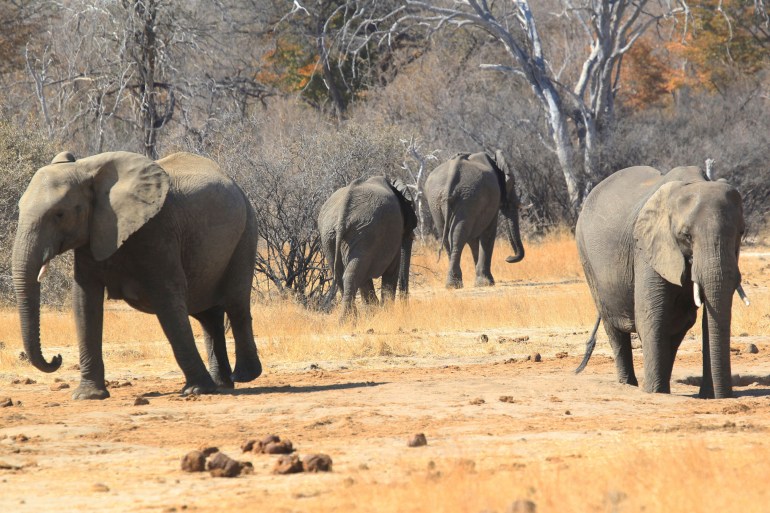They could be an superior sight to see from a secure distance on safari as they lumber round with their large, lopping ears and lengthy trunks, however for individuals who dwell facet by facet with elephants, these mammals can shortly change into a menace.
Elephants’ numbers in African international locations have dwindled massively up to now. Conservation efforts for the reason that Eighties, nonetheless, have seen populations get better considerably. In Southern African international locations, the place about half of the African elephant inhabitants resides, their greater numbers imply they’re beginning to come into battle with people.
Because of this, a few of these international locations have tried to cut back their elephant numbers. In Botswana, which has the most important variety of elephants on this planet, President Mokgweetsi Masisi has sought to push controversial insurance policies, just like the promotion of searching by wealthy vacationers. Final month, he lashed out on the German authorities for contemplating a ban on the import of elephant components, threatening to ship Berlin 20,000 of its jumbos.
The diplomatic spat made catchy headlines. However it belied the intense challenges dealing with elephants, rural communities and conservationists working to search out options.
How have elephant numbers modified up to now?
Following lengthy intervals of overhunting and poaching for his or her meat and costly ivory tusks, elephant numbers collapsed dramatically throughout Africa between the Seventies and 80s. About 100,000 elephants have been killed annually throughout that point, in line with the World Wildlife Fund (WWF). Whereas an estimated three to 5 million elephants roamed the continent round 1930, the quantity had fallen to 1.3 million in 1979, the WWF says. In response to researchers who’ve seemed again so far as the 1500s, elephant populations in Africa have shrunk by some 98 p.c.
Numbers continued to fall from 1979 till conservation practices – together with essential bans on gross sales of elephant components and trophy searching – halted the decline. Whole elephant numbers in Africa at the moment stand at about 415,000, in line with WWF estimates.
That is nonetheless low in contrast with historic numbers. Specifically, the Worldwide Union for Conservation of Nature (IUCN) lists the African bush elephant as endangered and the African forest elephant as critically endangered, which means they nonetheless face the specter of extinction.
The African bush elephant is a much bigger animal inhabiting the savannah grasslands of Southern and Japanese Africa, making up 70 p.c of the whole inhabitants on the continent. Its cousin – the African forest elephant – is native to Western and Central Africa and is recognisable by its smaller, rounded ears and brief, pointed tusks.
Botswana, Namibia, Angola, Zambia and Zimbabwe collectively account for greater than half of the African bush elephant inhabitants. Botswana alone is house to about 130,000 bush elephants – about half of the area’s numbers. It’s a large nation with a small inhabitants of two million folks, comparable in measurement to France, which has a inhabitants of 67 million. For each 15 folks in Botswana, there’s about one elephant.
Zimbabwe has the second-largest bush elephant inhabitants at about 100,000.

Why have rising numbers of elephants change into a problem?
The biggest residing land animals’ feeding habits can dramatically alter ecosystems throughout their roughly 60 years of life. They’ve few pure predators to handle their numbers in addition to people and, with folks out of the way in which, elephants can populate shortly, says researcher Lucy King from the non-profit organisation, Save the Elephants.
“When left alone, they breed fairly effectively [and] their numbers can go up fairly steadily over time as a result of their survival charge is fairly good,” King says.
Throughout the identical time that elephant numbers have steadied, human inhabitants progress has doubled throughout Africa. In Southern and Japanese Africa, the inhabitants grew from 312 million in 1994 to 633 million in 2021 in line with the United Nations Inhabitants Fund. That progress has seen people occupy extra land space and more and more encroach on wildlife habitats. Settlements and farms have additionally minimize roaming wildlife off from water or meals sources.
Because of this, people and elephants are coming into extra frequent contact and are clashing over the identical sources. Foraging herbivores usually roam onto farms, rip open thatch roofs on huts searching for meals or trigger harm to water pipes and different infrastructure. This has prompted offended locals to retaliate and assault them. These interactions might be deadly for each man and beast.
Local weather change has additionally precipitated extra elephants to wander additional than they as soon as would have – and to extra unpredictable locations – to hunt scarce meals and water.
Zimbabwe is a peak battle website, however human-elephant clashes are more and more occurring throughout the area, King says.
Nations like Zimbabwe and Botswana blame elephant overpopulation and argue that lowering their numbers would scale back these clashes. Nonetheless, some specialists reject this suggestion, stating that there was once many extra elephants in Africa.
How have governments tried to deal with the difficulty?
South Africa, Namibia, Zimbabwe and Botswana have all tried to cut back the variety of elephants of their territory at sure factors, however almost all their strategies have been met with criticism or outright condemnation from animal welfare organisations.
One follow is culling – the deliberate focusing on and killing of a number of animals, often complete households, collectively.
This follow was well-liked across the Eighties and 90s. In South Africa’s Kruger Park, a culling marketing campaign noticed about 14,000 elephants killed between 1967 and 1995. Nonetheless, the follow was outlawed after African international locations confronted a world backlash, corresponding to widespread requires vacationers to boycott international locations culling elephants.
Nonetheless, in 2008, South Africa defied the worldwide outcry and lifted its culling ban. In 2021, Zimbabwe – which had killed about 50,000 elephants between 1967 and 1988 – mentioned it was contemplating bringing again the follow.
Conservationists corresponding to King argue that culling is especially merciless for elephants, who’re emotionally clever and may expertise trauma. In addition to, the strategy shouldn’t be efficient and can “hardly scratch the floor”, she says.
Governments have additionally tried to easily dump a part of their herds, though animal welfare teams say elephants could possibly be shipped to zoos and used for human leisure.
In 2021, Namibia auctioned 170 elephants however bought solely a 3rd – at 5.9 million Namibian {dollars} ($400,000). There was a lot dangerous press and criticism of the sale that patrons have been discouraged, officers mentioned.
One other solution to management numbers is by permitting trophy searching, whereby international locations license journey seekers – often vacationers from america and different Western international locations – to kill a restricted variety of animals in particular, allotted areas for his or her horns, skins and tusks. Usually, these vacationers goal male elephants – or bulls – for his or her larger tusks.
Authorities officers in Southern Africa – and hunters themselves – argue that searching helps handle the elephant inhabitants naturally and gives income for native communities. That in flip incentivises native communities to cease unlawful poaching and to make sure that elephant numbers stay regular — and by no means drop beneath a sustainable stage. Looking licences can price as a lot as $10,000, relying on the animal being hunted.
African governments are sometimes angered by the concept of Western international locations telling them the follow is unethical – therefore the menace by Botswana to ship 20,000 elephants to Germany. Botswana’s President Masisi has been a specific advocate for the return of searching licences. In 2019, after he took workplace, Botswana lifted a five-year ban on elephant searching.
What are the arguments towards searching?
Some conservationists dismiss this anger from African governments.
“I simply assume it’s extraordinarily shortsighted. I believe it’s a handy smokescreen behind which to cover and justify trophy searching which is large enterprise,” says Ross Harvey, a wildlife economist with the non-profit organisation Good Governance Africa. Harvey factors out that a lot of the funds from trophy searching – first launched in colonial Kenya – go to rich businessmen who personal trophy searching corporations, slightly than into conservation efforts.
“How a lot of it truly finally ends up going to conservation is very questionable, actually not sufficient to preserve the panorama, and the way a lot of it accrues to poor neighborhood members can be extraordinarily unclear,” he provides. “However now that elephant is gone, now you reside with the unfavorable results of getting taken out all of the bulls – usually of their reproductive peak.”
Older males usually assist information youthful bulls, educating them the place to search out meals and water, or how you can behave. When they’re killed, youthful males can change into aggressive, researchers have discovered.
“My prediction is that you simply’re going to see a rise in human and elephant battle as a result of whenever you take out all of the bulls which can be answerable for disciplining the herd, then crop raiding goes to extend, not lower,” says Harvey.
So, what’s the resolution?
Harvey says whereas elephant numbers might have elevated for the reason that Nineties, the actual drawback shouldn’t be one in all “overpopulation” however slightly of people reducing off connecting land strips or corridors which elephants – and all wildlife – use emigrate searching for meals and habitat. Liberating up these areas, he argues, will scale back human-elephant interactions.
“Should you shoot them, you simply exacerbate the issue,” he says.
“There’s solely two options actually,” says King. “One, to have respiratory house. We preserve throwing up fences in every single place and stopping [elephants], in order that they get squeezed into areas the place they will then deplete the vegetation extremely quick. The one resolution is to launch the valves and ensure the fences come down. That doesn’t imply that elephants must be in every single place … however you may’t fence elephants in.”
In northern Botswana, one initiative referred to as the “Eco-Exist Mission” labored with locals to determine and demarcate greater than 60 elephant corridors throughout the sprawling Okavango Delta. The workforce then labored with communities to replan village layouts, in order that farms, houses and different infrastructure could be positioned away from these “elephant highways”.
It’s not but clear how a lot this venture has lowered human-elephant battle, however some 65,000 hectares (160,600 acres) of farmland belonging to 500 farmers, have been protected to date. Farmers have additionally clustered to share farm areas which they’ve ringed with fences or crops corresponding to chilli – which elephants dislike and subsequently keep away from.
One other resolution, King says, is to show folks how you can dwell extra harmoniously with the animals. Her analysis on pure methods to fend off elephants from settlements and farms in southern Kenya has yielded some outcomes.
King discovered that when she performed sound recordings of swarming bees, elephants would disperse in a rush. She then began to experiment with constructing beehive fences round a number of farmsteads. This can be a rudimentary methodology which is appropriate for rural communities – farmers want solely poles to mount packing containers housing the hives. Girls then harvest the honey and promote it for some facet earnings. The strategy is now being employed in 17 African international locations and a few areas in Asia.
“We’re actually proud about it … and it’s fully open supply,” King says. “We let folks have the manuals, develop their very own bio fence venture, and run with it. And the attention-grabbing factor is it’s actually working in every single place.”
Nonetheless, the strategy works for small land areas solely. It’s also threatened by drought – which isn’t conducive for bees.



